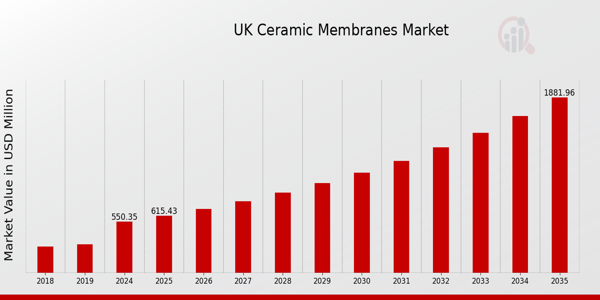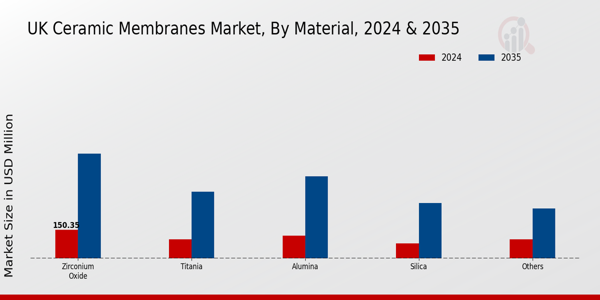UK Ceramic Membranes Market Overview
The UK Ceramic Membranes Market Size was estimated at 495 (USD Million) in 2023. The UK Ceramic Membranes Industry is expected to grow from 550.35 (USD Million) in 2024 to 1,882 (USD Million) by 2035. The UK Ceramic Membranes Market CAGR (growth rate) is expected to be around 11.826% during the forecast period (2025 - 2035).
Key UK Ceramic Membranes Market Trends Highlighted
The UK Ceramic Membranes Market is undergoing substantial development as a result of the growing demand for efficient filtration systems in a variety of industries, such as pharmaceuticals, food and beverage, and water treatment. The stringent regulations regarding water quality and effluent management in this region are a significant market driver, as they encourage industries to implement advanced filtration technologies. Furthermore, the United Kingdom government is dedicated to sustainable practices and is advocating for the use of ceramic membranes due to their extended lifespans and reduced maintenance expenses, which increase their appeal to both manufacturers and end-users.
Advancements in membrane technology that can result in reduced operational costs and enhanced performance are among the opportunities that should be investigated. Novel applications of ceramic membranes, such as in microalgae harvesting and sustainable agriculture, are the focus of research and development efforts in the UK, which have the potential to open up new markets. The integration of ceramic membranes is further bolstered by the trend toward increased automation in manufacturing processes, which improves efficiency and minimizes human error in operations.
In recent years, there has been an increasing interest in hybrid systems that integrate ceramic membranes with other filtration methods, providing increased flexibility and capabilities to accommodate a wide range of industry requirements.
Furthermore, the United Kingdom's industrial sectors have been encouraged to decarbonize, which has sparked interest in the use of ceramic membranes to capture carbon and other emissions. This is consistent with the nation's net-zero objectives. In general, the UK Ceramic Membranes Market is poised for expansion as businesses adjust to regulatory requirements, emergent technological advancements, and a dedication to sustainability.

Source: Primary Research, Secondary Research, Market Research Future Database and Analyst Review
UK Ceramic Membranes Market Drivers
Increasing Demand for Water Treatment Solutions
The growing necessity for advanced water treatment solutions in the UK is a significant driver for the UK Ceramic Membranes Market Industry. With an increasing population and stringent government regulations concerning water quality, it is estimated that approximately 3.1 million people in the UK lack access to safe drinking water. This scenario is prompting local authorities, such as the Department for Environment, Food & Rural Affairs, to invest heavily in technology that can improve water purity.
Ceramic membranes are known for their superior filtration capabilities, making them ideal for municipal water treatment. The UK government has been encouraging investments in innovative water treatment technologies, which is likely to further expand the market for ceramic membranes, as they are critical for meeting strict regulatory compliance and sustainability goals.
Rising Industrial Applications and Adoption
The increasing use of ceramic membranes in various industries such as food and beverage, pharmaceuticals, and chemical processing acts as another important market driver for the UK Ceramic Membranes Market Industry. The food and beverage sector alone is projected to reach a value of approximately 32 billion in the UK by 2025, according to industry reports. As food safety regulations tighten, manufacturers are adopting ceramic membranes to ensure product quality while also enhancing processing efficiency.
Industrial players like Diageo and Unilever are actively researching and implementing ceramic membrane technologies to enhance their operational efficiencies, thus reinforcing the demand for ceramic membranes in the UK.
Growing Investments in Research and Development
The UK has seen a notable increase in investments in Research and Development (R&D) of ceramic membrane technologies. According to the UK Research and Innovation (UKRI), investments in advanced materials, including ceramic membranes, have significantly ramped up, with funding reaching upwards of 1 billion annually. This trend is spurring innovations that lead to improved membrane performance, durability, and cost-effectiveness. Established organizations like the University of Manchester and Imperial College London are conducting groundbreaking research in ceramic membrane technology.
These efforts diminish the barriers to entry for new market players and increase the overall industrial capacity, positioning the UK Ceramic Membranes Market Industry for robust growth.
Environmental Sustainability Initiatives
With the UK government aiming for ambitious targets in carbon neutrality by 2050, the demand for environmentally sustainable solutions is driving the growth of the UK Ceramic Membranes Market Industry. The UK is committed to reducing plastic waste, and ceramic membranes provide a sustainable alternative for various filtration applications, thus helping various sectors minimize their environmental footprint. As part of the UK's Green Deal, many businesses are pivoting to sustainable manufacturing practices, and ceramic membranes, known for their long life-cycle and recyclability, are becoming increasingly popular.
Organizations such as WRAP (Waste and Resources Action Programme) are promoting the use of innovative materials like ceramic membranes as part of their broader agenda for sustainability, serving to enhance their widespread adoption.
UK Ceramic Membranes Market Segment Insights
Ceramic Membranes Market Material Insights
The UK Ceramic Membranes Market, particularly within the Material segment, is influenced by various key components such as Alumina, Zirconium Oxide, Titania, Silica, and others, each playing a significant role in the overall market dynamics. Alumina membranes are widely recognized for their high mechanical strength and chemical stability, making them popular in water treatment and industrial processes. Zirconium Oxide membranes are notably favored for their thermal resistance and are often utilized in higher temperature applications, providing effective separation and filtration solutions.
Titania, on the other hand, is acknowledged for its photocatalytic properties, enhancing wastewater treatment processes and contributing to environmental sustainability efforts within the UK.
Silica-based membranes are known for their biocompatibility and are increasingly applied in pharmaceutical industries and biotechnology, presenting opportunities for growth in specific niches. The market is supported by ongoing Research and Development activities aimed at improving the performance and cost-effectiveness of these materials. Furthermore, the demand for advanced filtration solutions due to regulatory pressures and environmental concerns shapes the market growth trajectory. The diversity of materials in the UK Ceramic Membranes Market highlights the unique applications and competencies of each material, positioned to address varying industry needs while fostering innovation and sustainability.
The combination of increasing industrial applications and the push for ecological solutions sets a promising landscape for the Material segment's future in the UK.
As industries progressively adopt ceramic membrane technology, the potential for advancements and enhanced performance across various materials creates a robust pathway for market expansion. The interplay between these materials underscores their importance in shaping the market, each contributing uniquely to the performance and efficiency of ceramic membrane applications across several sectors in the UK.

Source: Primary Research, Secondary Research, Market Research Future Database and Analyst Review
Ceramic Membranes Market Application Insights
The UK Ceramic Membranes Market segmentation within the Application sector highlights several key areas including Water and Wastewater Treatment, Food and Beverage, Biotechnology, Pharmaceuticals, and Others, each playing a vital role in addressing specific industry challenges and opportunities. Water and Wastewater Treatment remains a critical focus, driven by the increasing regulatory demands for water quality and resource sustainability. The Food and Beverage segment benefits from stringent hygiene standards and the need for efficient processing, making ceramic membranes essential for achieving high product purity.
In Biotechnology, the demand for advanced filtration techniques supports the growth of ceramic membranes, particularly in processes requiring precise control over particle size and microbial contaminations. The Pharmaceuticals sector values ceramic membranes for their role in ensuring drug safety and efficacy through meticulous separation processes. Other applications continue to expand as diverse industries recognize the durability and efficiency of ceramic membranes in their operations. The prevailing market trends indicate a significant upward trajectory in adoption across these segments, driven by technological advancements and the growing need for sustainable solutions in the UK.
Ceramic Membranes Market Technology Insights
The UK Ceramic Membranes Market, particularly in the Technology segment, has experienced notable developments, driven by increasing awareness of water treatment and filtration processes. Ultrafiltration is significant in the market due to its capability of removing larger molecules, making it essential for applications in food processing and wastewater treatment. Microfiltration, while similar, primarily targets smaller particles and is crucial in the beverage and pharmaceuticals sectors. Nano-Filtration plays a critical role in providing higher separation efficiency for specific ions and small organic molecules, thus supporting industries such as desalination and chemical processing.
Other technologies are also emerging, contributing to innovations and diverse applications in the ceramic membranes landscape. The rising demand for efficient and sustainable filtration solutions is shaping the UK Ceramic Membranes Market, with emphasis on regulations and sustainability trends in industrial practices. Operational efficiencies and technological advancements continue to drive market growth, resulting in opportunities for market players to innovate and expand their offerings. Overall, the segmentation within the Technology sector reflects a dynamic evolution, aligning with the growing emphasis on environmental regulations and process optimization in various industries across the UK.
UK Ceramic Membranes Market Key Players and Competitive Insights
The UK Ceramic Membranes Market is characterized by its rapid growth and innovation, driven by increasing environmental concerns, strict regulatory standards, and a rising demand for efficient water and wastewater treatment solutions. As the market expands, competitive insights reveal a landscape where several key players are working diligently to enhance their operational efficiencies and innovate their product offerings. These companies are involved in various aspects of the ceramic membranes sector, including research and development, manufacturing, and distribution, driven by the demand for high-performance filtration technologies.
The competitive dynamics are influenced by factors such as technological advancements, strategic collaborations, and geographic presence, all of which contribute to the overall market strength and the ability of companies to maintain a competitive edge in this evolving space.
Mitsubishi Chemical Corporation holds a significant position in the UK Ceramic Membranes Market. The company leverages its extensive experience in advanced materials and filtration technologies to offer high-performance ceramic membranes designed for various applications, including industrial wastewater treatment and potable water production. Their products are distinguished by superior durability and reliability, making them ideal for challenging operational environments. Mitsubishi Chemical Corporation's strengths lie in its robust research and development capabilities, which facilitate continuous innovation and adaptation to market trends.
These advantages have allowed the company to sustain its competitive edge, responding effectively to increasing demand for sustainable water solutions within the UK.
GE Water and Process Technologies plays a pivotal role in the UK Ceramic Membranes Market, providing leading-edge water treatment solutions that utilize ceramic membrane technology. The company offers a range of products and services that cater to different sectors, including municipal water treatment, food and beverage processing, and pharmaceutical applications. GE Water and Process Technologies are recognized for their commitment to sustainability and efficiency, employing innovative processes to enhance water quality and operational performance.
The company has a strong market presence in the UK, supported by strategic mergers and acquisitions that have enabled it to expand its capabilities and product portfolio. Additionally, GE Water and Process Technologies emphasizes collaboration with local entities to ensure tailored solutions that meet the specific needs of the UK market, enhancing its overall competitiveness in the ceramic membrane’s domain.
Key Companies in the UK Ceramic Membranes Market Include
- Mitsubishi Chemical Corporation
- GE Water and Process Technologies
- SUEZ Water Technologies and Solutions
- Evoqua Water Technologies
UK Ceramic Membranes Market Industry Developments
The UK Ceramic Membranes Market has seen notable developments recently, particularly as companies work to enhance their technologies and product offerings. Mitsubishi Chemical Corporation and GE Water and Process Technologies have been active in expanding their portfolios, with increased investments in Research and Development to improve membrane performance and sustainability. Companies like Evoqua Water Technologies and Koch Membrane Systems are focusing on applications that cater to water treatment and wastewater management, driving market growth due to heightened environmental regulations and the need for clean water access across the UK.
In September 2022, Pall Corporation acquired a smaller filtration technology company to strengthen its capabilities in the ceramic membranes sector, a move that has been positively received in the market. Over the last two to three years, the UK government's commitment to addressing water scarcity issues and improving waste management has favored growth in this sector, with an emphasis on innovative technologies from brands like Pentair and Hydranautics. According to industry reports, the market valuation of UK ceramic membranes is experiencing upward trends, attributed to increasing demand from various sectors, including pharmaceutical and food and beverage industries.
UK Ceramic Membranes Market Segmentation Insights
Ceramic Membranes Market Material Outlook
- Alumina
- Zirconium Oxide
- Titania
- Silica
- Others
Ceramic Membranes Market Application Outlook
- Water & Wastewater Treatment
- Food & Beverage
- Biotechnology
- Pharmaceuticals
- Others
Ceramic Membranes Market Technology Outlook
- Ultrafiltration
- Microfiltration
- Nano-Filtration
- Others
|
Report Attribute/Metric
|
Details
|
|
Market Size 2023
|
495.0(USD Million)
|
|
Market Size 2024
|
550.35(USD Million)
|
|
Market Size 2035
|
1882.0(USD Million)
|
|
Compound Annual Growth Rate (CAGR)
|
11.826% (2025 - 2035)
|
|
Report Coverage
|
Revenue Forecast, Competitive Landscape, Growth Factors, and Trends
|
|
Base Year
|
2024
|
|
Market Forecast Period
|
2025 - 2035
|
|
Historical Data
|
2019 - 2024
|
|
Market Forecast Units
|
USD Million
|
|
Key Companies Profiled
|
Mitsubishi Chemical Corporation, GE Water and Process Technologies, Membrana, Pentair, Xflow, Hyflux, Hydranautics, SUEZ Water Technologies and Solutions, Evoqua Water Technologies, Koch Membrane Systems, Memsys, 3M, Porvair Filtration Group, Pall Corporation, Lenntech
|
|
Segments Covered
|
Material, Application, Technology
|
|
Key Market Opportunities
|
Increased water treatment demand, Energy-efficient filtration solutions, Growing pharmaceutical applications, Adoption in food and beverage industry, Expansion in waste management sector
|
|
Key Market Dynamics
|
growing demand for wastewater treatment, stringent environmental regulations, advancements in membrane technology, increasing industrial applications, competitive pricing pressure
|
|
Countries Covered
|
UK
|
Frequently Asked Questions (FAQ):
The UK Ceramic Membranes Market is expected to be valued at 550.35 USD Million in 2024.
By 2035, the market size is projected to reach 1882.0 USD Million.
The expected CAGR for the UK Ceramic Membranes Market from 2025 to 2035 is 11.826%.
Key materials include Alumina, Zirconium Oxide, Titania, Silica, and Others, with significant market shares.
The market value of Alumina in 2024 is estimated to be 120.0 USD Million.
Zirconium Oxide is expected to reach a market value of 550.0 USD Million by 2035.
Major players include Mitsubishi Chemical Corporation, GE Water and Process Technologies, and SUEZ Water Technologies among others.
The market presents growth opportunities driven by technological innovations and increasing demand for water treatment applications.
The current global scenarios may create both challenges and opportunities that can affect market dynamics and pricing.
By 2035, the projected market size for Titania is anticipated to be 350.0 USD Million.
















